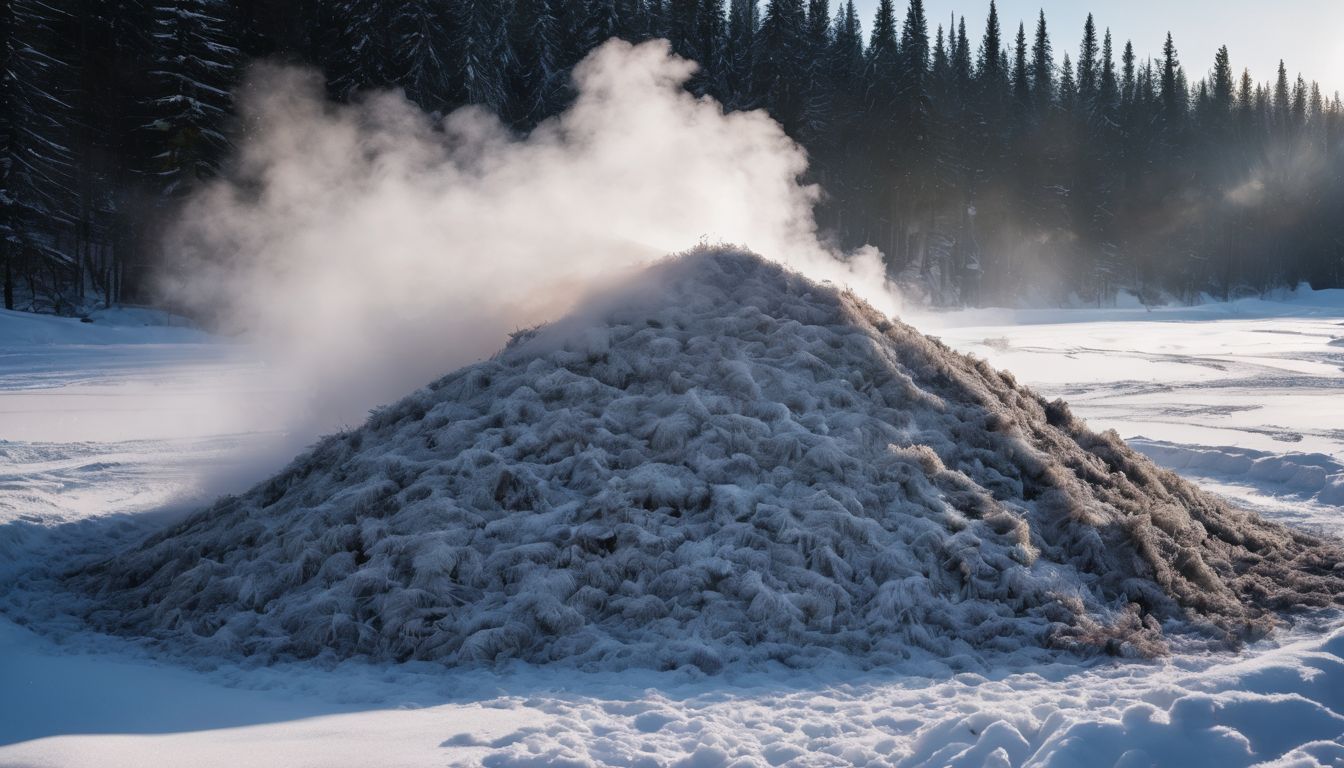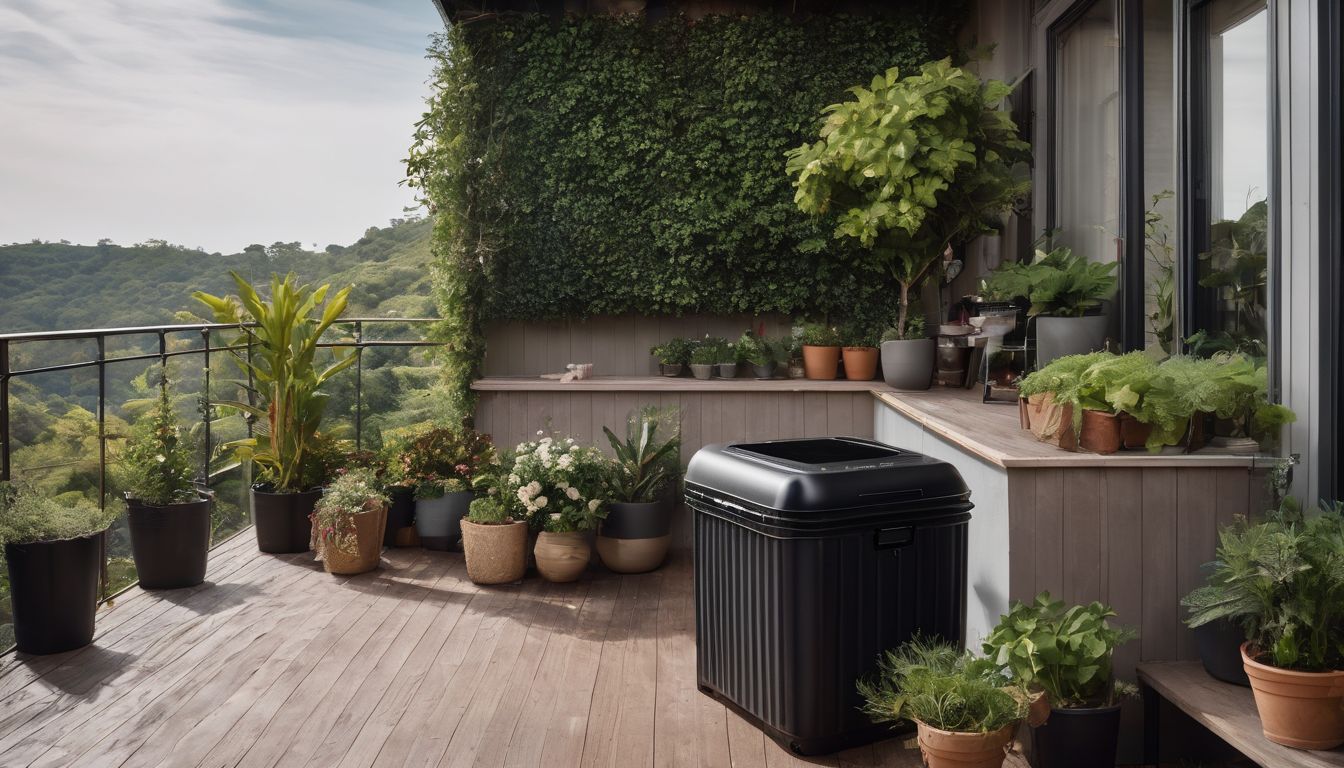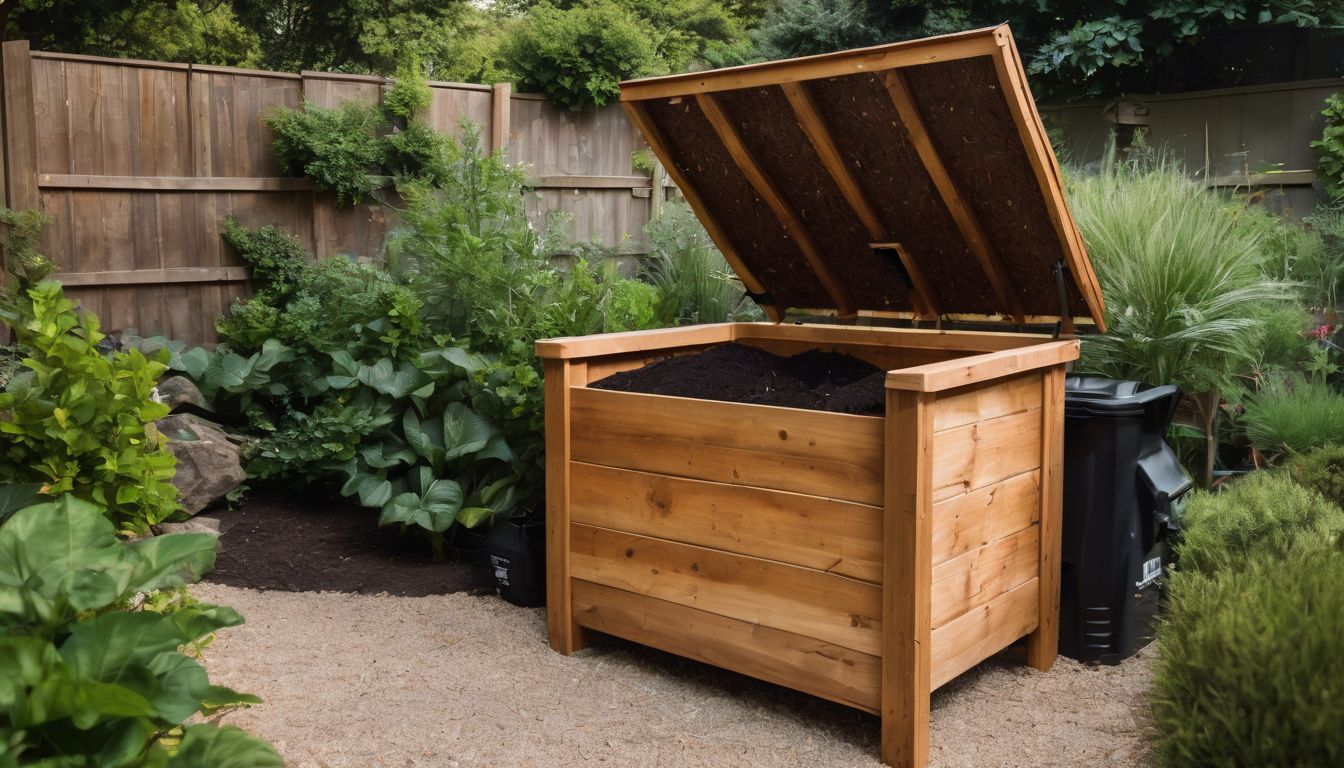 Winter’s chill doesn’t have to freeze your composting efforts. Despite widely held beliefs, the decomposition process can continue through the cold months. This article will guide you on how to maintain a thriving compost heap even when temperatures drop.
Winter’s chill doesn’t have to freeze your composting efforts. Despite widely held beliefs, the decomposition process can continue through the cold months. This article will guide you on how to maintain a thriving compost heap even when temperatures drop.
Read on for frost-proof tips!
Key Takeaways
- Insulating your compost bin is essential in winter to retain the warmth needed for decomposition. Use materials such as straw bales, bubble wrap, or old blankets to keep your compost heap active during cold months.
- Keep a balance of green (nitrogen-rich) and brown (carbon-rich) materials in your compost throughout winter; freeze kitchen scraps before adding them to prevent rotting and speed up the breakdown process.
- Regularly turning the compost helps introduce oxygen, preventing compaction and maintaining an environment conducive to microbial activity that’s necessary for effective decomposition even when temperatures are low.
- Utilising the final product of winter composting can be done by mixing it with soil as a rich growing medium or using it as mulch around plants; this not only enriches garden beds but also provides vital nutrients come spring planting season.
- Compost tumblers can be effective in winter if kept insulated and turned regularly; maintaining correct moisture levels and adding smaller pieces of organic waste facilitate faster decomposition.
The Benefits of Composting in Winter
Composting in winter provides nutrient-rich soil for spring planting and reduces waste.
Nutrient-rich soil for spring planting
Creating a winter compost pile means your garden will thank you come spring. As food scraps and yard waste break down, they create a dark, crumbly substance full of nutrients that plants love.
By adding this homemade compost to your garden beds, you’re ensuring your vegetables and flowers have the best start when the growing season kicks in.
Adding layers of green and brown materials throughout the cold months enriches the resulting compost with a balanced mix of nitrogen and carbon. This process helps improve soil structure, which allows roots to spread out easily and access water more efficiently.
Your spring planting efforts are rewarded with robust growth and healthier crops as they draw from soil teeming with beneficial microbes fostered by your diligent winter composting.
Reduced waste
To support conservation efforts, winter composting helps reduce waste by diverting organic materials from landfills. When kitchen scraps and yard waste are composted, they break down naturally to create nutrient-rich soil.
This reduces the amount of waste that needs to be disposed of in landfills, benefiting the environment and promoting sustainable living.
Maintaining a compost pile through winter ensures that valuable organic matter isn’t wasted. With proper care and attention, even during the colder months, it’s possible to continue reducing household waste through effective composting practices.
Challenges of Winter Composting
Composting in winter poses several challenges due to freezing temperatures, limited composting materials, and slower decomposition. These obstacles can make it more difficult to maintain a healthy and productive compost pile during the colder months.
Freezing temperatures
Freezing temperatures pose a challenge to winter composting due to the slowdown in decomposition. However, insulating the compost bin and adding the right mix of materials can help maintain ideal conditions for decomposition even in cold climates.
Through careful monitoring of moisture levels and adjusting the ingredients accordingly, it is possible to overcome the obstacle of freezing temperatures affecting the composting process.
To combat freezing temperatures, consider setting up a winter compost bin with proper insulation to retain heat. This will allow for continued microbial activity and help accelerate decomposition despite ambient cold weather.
Limited composting materials
To address the challenges posed by freezing temperatures, it’s essential to acknowledge the limited availability of composting materials during winter. This scarcity can be a result of reduced garden waste, fewer fresh organic kitchen scraps, and slower decomposition rates due to colder ambient temperatures.
However, despite these limitations, there are still ways to continue composting effectively throughout the winter months.
One approach is to supplement with alternative carbon-rich materials such as shredded newspaper, cardboard, sawdust, or straw. By incorporating these items into your compost pile or bin alongside kitchen scraps and garden waste that may still be available in smaller quantities, you can maintain a balanced mix of green and brown materials necessary for successful decomposition.
Slower decomposition
To overcome the challenge of limited composting materials, it is important to address the issue of slower decomposition during winter. The colder temperatures slow down the microbial activity in the compost pile, resulting in a longer breakdown process for organic matter.
This can lead to a buildup of materials and hinder efficient composting. However, there are strategies that can help mitigate this issue and maintain an active decomposition process despite the cold weather.
Adding insulating layers to your compost pile or using a designated winter compost bin with proper lid closures can help trap heat and create an environment more conducive to decomposition.
Tips for Successful Winter Composting
Set up a winter compost bin with a lid to retain heat. Freeze kitchen scraps before adding them to the compost to prevent them from rotting in cold temperatures. Monitor moisture levels and add the right ingredients for proper decomposition.
Insulate the bin for heat retention and utilise the winter compost outputs for spring gardening.
Set up a winter compost bin with a lid
Freeze kitchen scraps
Freezing kitchen scraps before adding them to your compost bin helps to break down the organic matter more effectively. Here are some tips for freezing kitchen scraps:
- Collect kitchen scraps like fruit peel, vegetable trimmings, coffee grounds, and eggshells in a freezer-safe container or bag.
- Keep the scraps in the freezer until you’re ready to add them to your compost bin.
- Freezing the scraps helps to break down cell walls, making it easier for microorganisms to decompose them.
- It also helps to control odours and reduce fruit fly activity in the kitchen.
Monitor moisture levels and add the right ingredients
Monitor moisture levels to ensure the compost remains damp but not waterlogged. Use a compost moisture meter or simply feel the compost with your hands. Add dry materials like leaves, shredded paper, or straw if moisture levels are too high. Balance wet components with dry ones to maintain ideal conditions. Incorporate kitchen scraps, yard waste, and carbon-rich materials in layers to encourage decomposition. Adjust the mix of green and brown materials as needed to keep the compost thriving. Check the compost regularly for any signs of imbalance in moisture or ingredients.
Insulate the bin for heat retention
To ensure the microbes in your compost bin continue to function optimally during cold weather, insulating the bin is crucial for heat retention. This prevents the internal temperature from dropping too low and slows down the decomposition process. Here are practical ways to insulate your compost bin effectively:
- Use straw bales or hay around the exterior of the bin to create a buffer against freezing temperatures.
- Wrap the bin with insulating materials such as bubble wrap or old blankets to provide an extra layer of protection.
- Invest in a specially designed insulated compost bin that helps regulate internal temperatures more effectively.
- Position the compost bin in a sheltered area, shielded from harsh winds and direct exposure to extreme cold.
- Place a layer of cardboard or polystyrene underneath and around the sides of the compost bin to minimise heat loss into the ground.
- Consider incorporating a heat source such as a heating pad or small light bulb inside the bin to generate additional warmth during very cold spells.
- Check for any gaps, cracks, or holes in your compost bin where heat may escape and seal them using weatherproof materials.
- Monitor the internal temperature regularly and adjust insulation as needed to maintain suitable conditions for efficient winter composting.
Utilise winter compost outputs
To utilise winter compost outputs, consider using the nutrient-rich compost to top-dress your garden beds before spring planting. Mix the compost with soil to create a rich growing medium and provide essential nutrients for your plants. Additionally, you can use the compost as mulch around your trees and shrubs to help retain moisture and suppress weeds. Spread the compost on your lawn to improve soil structure and encourage healthy grass growth. Moreover, consider donating excess compost to local community gardens or urban farming projects in need of organic soil amendments. Use it as a base for creating homemade potting mixes for indoor plants or seed starting. Lastly, share surplus compost with friends and family who are also passionate about sustainable gardening practices.
- Mix compost with soil for rich growing medium
- Use as mulch around trees and shrubs
- Spread on the lawn to improve soil structure
- Donate excess compost to community gardens
- Create homemade potting mixes for indoor plants or seed starting
- Share surplus compost with friends and family
Prep for spring gardening
Prepare your garden for spring by utilising winter compost outputs and following these steps:
- Spread compost over the soil to enhance its fertility.
- Mix compost into potting soil for starting seeds indoors.
- Use compost as a mulch around garden plants to retain moisture and suppress weeds.
- Create a compost tea by steeping compost in water, then use it as a natural fertiliser for your plants.
- Start planning your spring garden layout and plant selection based on the nutrients provided by your winter compost.
Frequently Asked Questions
Can you compost in winter? Do compost tumblers work in winter? Do I need to turn the compost? Do winter compost piles heat up? How can I speed up winter composting? Find the answers to these questions and more by reading on!
Can you compost in winter?
Composting in winter is definitely possible. Cold weather does pose challenges, such as freezing temperatures and slower decomposition, but with the right strategies, you can successfully compost throughout the winter months.
By utilising a winter compost bin with a lid, insulating it for heat retention, monitoring moisture levels, and adding the right ingredients like frozen kitchen scraps, you can maintain an effective composting process even in colder climates.
Additionally, taking care of your winter compost outputs will prepare you for spring gardening by providing nutrient-rich soil for planting.
Do compost tumblers work in winter?
Compost tumblers can work in winter if managed properly. Keep the tumbler insulated to maintain warmth and speed up decomposition. Monitor the moisture levels, adding dry materials like leaves or straw when necessary to balance it out.
Turn the tumbler regularly to aerate the compost and distribute heat evenly. By following these steps, you can effectively use compost tumblers throughout the winter season.
Overall, winter doesn’t have to stop your composting efforts; with a few adjustments, you can continue creating nutrient-rich soil for your spring garden and minimise waste all year round.
Do I need to turn the compost?
To ensure efficient decomposition in winter, turning the compost regularly is essential. This helps aerate the pile, preventing it from becoming compacted and allowing oxygen to reach the microorganisms responsible for breaking down organic matter.
By turning the compost every few weeks, you can also evenly distribute moisture and heat throughout the pile, promoting balanced decomposition.
Regularly turning your compost during winter will help maintain an active breakdown process while ensuring proper aeration and distribution of vital nutrients for your garden soil come springtime.
Do winter compost piles heat up?
To ensure that your winter compost piles heat up, it’s crucial to insulate the compost bin to retain warmth. Adding carbon-rich materials such as straw, leaves, or shredded paper can help in generating heat during decomposition.
Additionally, monitoring moisture levels and turning the compost regularly will facilitate aeration and enhance the heating process. Utilising kitchen waste in layers with other organic materials can also contribute to creating heat within the pile.
By employing these methods, you can boost the temperature of your winter compost piles for efficient decomposition even in cold weather.
By maintaining insulation and adding appropriate ingredients while monitoring moisture levels, you can promote the heating of your winter compost piles. Rotate through different carbon-rich materials like straw or shredded paper to generate warmth during decomposition and ensure an ideal environment for active microbial activity within your compost pile.
How can I speed up winter composting?
To speed up winter composting, consider adding smaller pieces of kitchen waste to the compost bin. This helps increase the surface area for microbial activity and accelerates decomposition.
Additionally, mixing in “green” materials such as fresh grass clippings or coffee grounds can raise the temperature inside the bin and promote faster breakdown of organic matter.
Another way to hasten winter composting is by turning or aerating the pile regularly. This introduces oxygen, which supports aerobic decomposition and helps generate heat within the compost.
Conclusion
In conclusion, winter composting presents challenges but also offers opportunities for creating nutrient-rich soil and reducing waste. Insulating the compost bin, monitoring moisture levels, and using the right ingredients can help overcome winter obstacles.
By embracing these solutions, environmentally conscious individuals can continue their composting efforts year-round and prepare for successful spring gardening.
FAQs
1. What are the challenges of composting in winter?
Cold weather composting comes with challenges like maintaining the right temperature and moisture levels, which could slow down the decomposition process.
2. Can I still start composting kitchen waste in winter?
Yes, you can start kitchen waste composting in winter by using methods like insulating your compost bin to help maintain ambient temperatures conducive to decomposition.
3. How do I keep my compost active during freezing temperatures?
To keep your compost active in freezing temperatures, insulate your bin and regularly turn the contents or use a compost tumbler for better heat retention and distribution.
4. Are there benefits to continuing my compost through winter?
Winter composting benefits include giving you a head start on producing nutrient-rich soil for spring planting and reducing household waste throughout the year.
5. What should I monitor in my winter composting?
Monitoring moisture is key; ensure your pile doesn’t get too wet or dry out as either can halt the decomposing process during cold months.
6. How can I overcome obstacles when managing my composter during cold climates?
Overcoming winter composter obstacles involves insulating your composter properly, balancing green and brown materials to optimise heat generation, and turning it regularly for adequate aeration.





